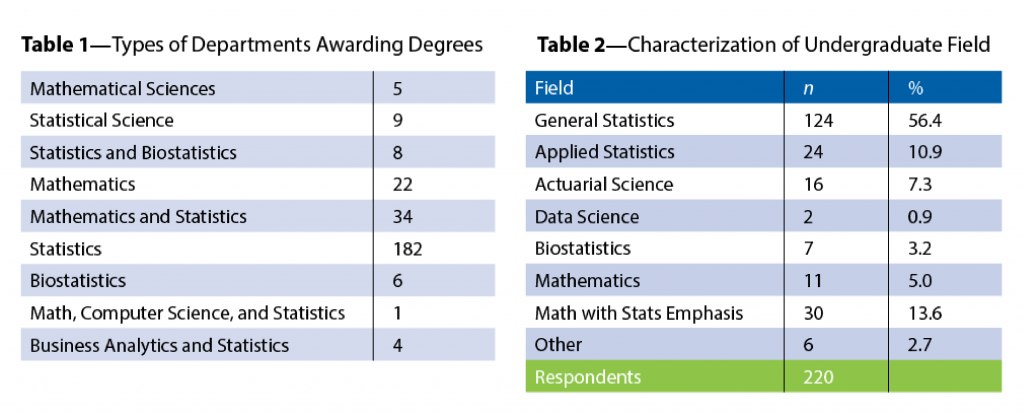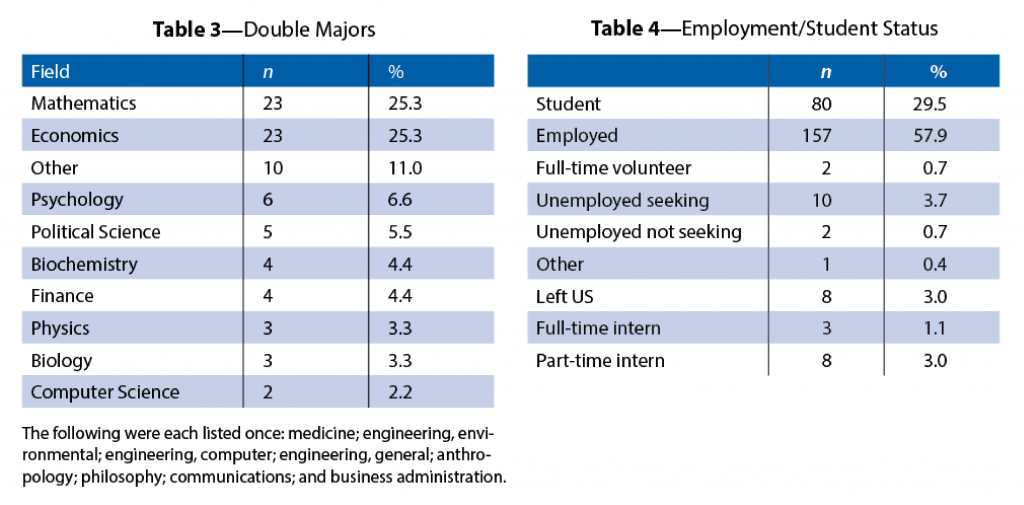First ASA Bachelor’s Survey Provides Snapshot of 2016 Graduates
Steve Pierson, ASA Director of Science Policy
The number of students earning bachelor’s degrees in statistics in the US tripled from 2010 to 2016. To better understand this growth, the ASA conducted its first survey of statistics bachelor’s graduates, starting with the class of 2016. The results should be helpful to the following three main audiences:
- Current statistics students as they contemplate their remaining studies and plan for post-graduation
- Potential statistics students as they decide on a major or majors
- Faculty and administrators as they advise students, design curricula, and allocate resources
The findings reveal information that can be broadly characterized as illuminating undergraduate studies, post-graduate studies, and post-graduate employment. To highlight a few features in each category, starting with undergraduate studies, many students wished they had taken more computer science/programming/coding courses and mathematics courses and advised current students to do so.
Good to Know
This survey was conducted by the Statistical Research Center of the American Institute of Physics (AIP). The ASA provided department names and contacts for the departments granting statistics or biostatistics degrees according to our records. The Statistical Research Center reached out to 123 departments, 41 of which provided names and email addresses of their 2015–2016 academic year graduates. The AIP received the names and contact information for 1,017 graduates.
The ASA plans to make this an annual survey and hopes to expand the survey to master’s degree graduates in the coming years.
Supplemental Material
Questionnaire
Raw Data
Comments
Participating Universities
Job Titles
Companies Employing Graduates
Also, nearly one-third of respondents double-majored, with economics and mathematics being the most common majors. Such extensive double majoring is consistent with the advice of 2016 ASA President Jessica Utts, whose initiative promoting the theme “statistics plus” showed that students can combine statistics with almost any other interest.
The respondents who had jobs outnumbered those in graduate school almost two to one. Those with jobs found themselves in a variety of companies with an especially wide array of job titles, reinforcing the belief that a statistics degree is widely applicable—allowing one to play in anyone’s backyard—and widely in demand. The median salary of $55,000 is in line with that of mathematics and finance majors.
The survey also asked those with jobs about their most-used skills. Consistent with what the ASA has been hearing and sharing, communications and team skills top the list. For technical skills, the most-reported were data analysis, technical problem-solving, programming, and quality control.
While the preliminary survey findings reported here provide a new perspective to the recent discussions in the statistical community about preparing students for the 21st-century workforce, they also reinforce many of the current perspectives. For instance, the 2015 Amstat News article titled “Guidelines for Undergraduate Programs in Statistical Science Updated” states the guidelines “call for adaptations to the undergraduate curriculum to account for the increased importance of data analysis, teamwork, communications, and other relevant skills and experiences in today’s practice of statistics.” Indeed, such themes are common in the pages of Amstat News, with a quick search finding Robert Starbuck and Paul Berg’s 2012 piece, “Communication, Influence Keys to Success in Statistics.”
More recently, the whitepaper and accompanying videos of presentations by employers who attended the 2016 ASA chairs workshop also point to more communication, interpersonal, and related skills. Also from that workshop was the notion that the statistics community needs to market itself and statistics more effectively. Statistics students may need to explain to potential employers what they bring to the table and why they should be hired.
The remainder of this article reports the survey’s data, which the ASA will continue to examine and report further on. Your thoughts and impressions are welcome—particularly as the survey of 2017 bachelor’s graduates is prepared. Send all comments to ASA Director of Science Policy Steve Pierson.
Survey and Results
Participating in the survey distributed in the spring of 2017 were 271 graduates. They were asked about employment or graduate student status as of March 6, 2016. Of those 271,215 answered the entire questionnaire. One hundred eighty three of the respondents reported being US citizens, and 32 reported being non-US citizens (17 from China, three from South Korea, and two from Canada.) The number of respondents, 271, is about 10% of the number of statistics and biostatistics graduates (2,790) as reported by the National Center for Education Statistics, 43% of whom are women. Of those providing gender identities, 87 were female, 125 male, and two “other.”
Undergraduate Studies
Two-thirds of the respondents graduated from a statistics department/school, as seen in Table 1. Of the 220 who characterized their undergraduate field (Table 2), 60% listed statistics or biostatistics. Ninety-two of the respondents said they graduated with a double major, with the most common companion major being economics and mathematics (Table 3).
Fifty-two universities or colleges in 29 states were represented by the respondents, with the University of Illinois at Urbana-Champaign having the most survey participants (25). One hundred seventy nine of the respondents graduated from universities for which the highest ativan online united states degree offered was a PhD, 67 of the respondents graduated from universities for which the highest degree offered was a master’s, and 25 of the respondents graduated from universities for which the highest degree offered was a bachelor’s. One hundred eighty one graduated from a public university, and 90 graduated from a private university.
One hundred five of the 221 who responded to the question said they had taken AP Statistics.
For questions relating to work outside of class assignments, 70 said they did a thesis or capstone project, 96 said they did an off-campus internship or industrial co-op, 60 said they did on-campus research, 16 said they did an NSF Research Experience for Undergraduates, 24 said they did other summer research on another campus, and 20 said they did a DataFest or hackathon.
Regarding their job search, 115 respondents said their statistics department or the faculty provided career guidance; 104 said they did not. Similarly, 115 said they used their on-campus career counseling center; 104 said they did not. Of those who used a campus career counseling center, 73 found it useful.
In response to questions about how well their undergraduate program prepared them, 84% agreed or strongly agreed their program prepared them to effectively analyze and interpret data critically using statistical models, 79% agreed or strongly agreed their program prepared them to effectively analyze and interpret data critically using computational methods, and 78% agreed or strongly agreed their program prepared them to effectively communicate—both orally and in written form—results of statistical analyses to a variety of audiences.
When asked if they would do anything differently, 40 said they would have taken more computer science, programming, or coding courses, and 18 said they would have taken more mathematics courses. Many also commented they wished they had applied themselves more to their studies, while others wished they had more research or hands-on experience.
In terms of advice for current statistics students, programming/coding skills were most frequently recommended, followed by gaining experience through internships and related activities. More mathematics, double majoring, and learning more statistical programming (e.g., R, SAS, SQL) were also recommended.
Postgraduate Work or Studies
Of the 271 respondents, 157 (60%) listed themselves as employed, 80 (30%) listed themselves as students, and 10 (4%) listed themselves as unemployed (see Table 4). Eighty-five listed themselves in full-time degree programs, and another 32 of the employed said they were planning to begin a degree program in the future.
Employed
The 157 graduates who categorized themselves as employed had jobs in 29 states, and 67 had a job in the same state as the institution from which they graduated.
For the 130 who reported themselves as employed and responded to the question about number of job offers they received, 65 reported one job offer, 37 reported two, 14 reported three, six reported four, and four reported five or more job offers. Eighty-five percent of those employed and who answered the question thought their statistics or statistics-related major was very or somewhat influential in securing their current position. Eighty-one percent were very or somewhat satisfied with the position they held as of March 6, 2017. Seventy-four percent were very or somewhat satisfied with their salary, 92% were very or somewhat satisfied with their job security, 77% were very or somewhat satisfied with the opportunity for advancement, 69% were very or somewhat satisfied with the intellectual challenge, and 83% were very or somewhat satisfied with their level of responsibility.
The median salary for those employed in data-related jobs and providing salaries is $55,000, the 25th and 75th percentiles being $47,500 and $66,500. For an approximate comparison, see the graph from the American Institute of Physics. Statistics tracks most closely with mathematics and finance. Table 7 shows the median salaries for the states with an n of five or greater. The median number of months between the reported month her/his job started and month of graduation was two.
There were 91 unique job titles among 127 job titles reported. The most common were analyst (9), data analyst (8), and actuarial analyst (8). One hundred five unique employers were listed, representing a wide range of sectors.
The questionnaire also asked those employed about the frequency in which they use many skills in their work. The use of more technical skills is shown in Table 5, where one can see technical problem-solving, programming, and data analysis are most often used and experimental and survey design are least often used. For interpersonal, communication, and management skills (Table 6), teamwork is by far the most often and widely used skill, followed by working with clients, project management, and writing.
Postgraduate Study
Seventy-four respondents reported being in a graduate program—30 in statistics, 10 in biostatistics, nine in data science, and the others in 15+ other programs (computer science and economics being the most common with three each). Seventeen of the graduates were enrolled in doctoral programs, while 49 were enrolled in master’s. Twenty-two respondents said they plan to enroll in a degree program in the next two to three years—12 in a doctoral program and 17 in a statistics program.






















